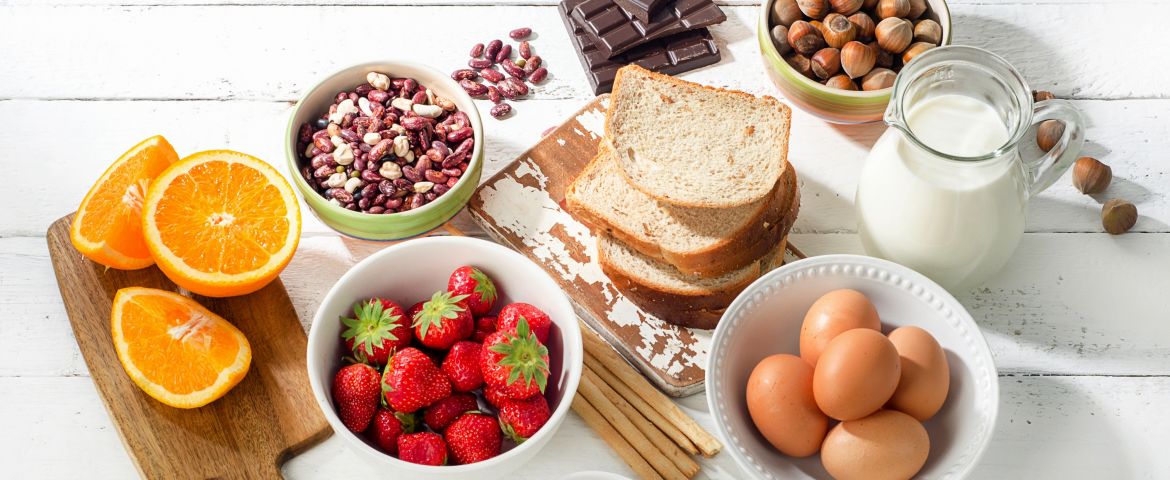About 32 million Americans, including 5.6 million children under the age of 18, have food allergies, and this number is increasing. Because there’s currently no cure for food allergies, taking precautionary steps to prevent a reaction from occurring is essential to protect your loved ones. These tips will help you manage food allergies at home to stay safe and live well.
- Read food labels.
You can’t always tell whether a food contains an allergen just by looking at it, so it’s important to understand how to read food labels. The Food Allergen Labeling and Consumer Protection Act (FALCPA) requires that the eight most common allergens—milk, egg, peanut, tree nuts, soy, wheat, fish and crustacean shellfish—be called out in the ingredient list or by using the word “Contains.” Non-FALCPA regulated allergens, including Molluscan shellfish and seeds that are in many spices, may be present in a food but are not required to be labeled. Statements such as “may contain” or “made on equipment with” are voluntary for manufacturers, so their absence does not indicate that a food is safe from that allergen. Additionally, phrases such as “peanut-free” and “egg-free” are not regulated and those foods can be made in facilities where the allergens are present. Food allergens can appear in surprising places, so it’s important to know your allergen inside and out, including the less-common names they go by. If you’re unsure whether a product contains or has come into contact with a food allergen, calling the manufacturer is the safest bet.

- Stock up on food allergen substitutes.
Avoiding the allergen in the first place is the best way to prevent a reaction. Keep safe substitute foods for common allergens on hand, such as sunflower seed butter, coconut milk or almond flour. If you’re preparing a new recipe that unexpectedly calls for the allergen, you’ll have something to fall back on. It’s also easier to plan meals when you’re familiar with cooking with those substitutes and don’t have to worry whether or not you have safe ingredients available. - Separate safe and unsafe foods.
When you’re putting groceries away, keep the safe and unsafe foods separated. Assign specific shelves in the refrigerator and pantry—and store the food in sealed containers—to avoid contamination. Some families even label or color code the actual food products to ensure they don’t get mixed up. - Label dishware and utensils.
Similar to keeping your foods separated, the dishware used to prepare meals should also be kept separate from one another. Label distinct sets of utensils and other cooking tools as “safe” and “unsafe” to avoid cross-contact. Whether you label your dishware or not, do not allow allergen-covered utensils to touch “safe” foods, such as using a knife to spread peanut butter and then inserting it into a jar of jam. After using a utensil on an “unsafe” food, immediately put it in the sink or dishwasher. - Prepare the safe meal first.
When you’re cooking for a family, it’s not always practical to exclude the allergen from every meal; preparing two versions of the meal is a good alternative. To keep the allergen-free meal as safe as possible for your loved one, you should prepare it before the meal containing the food allergen. This makes the dishware and kitchen area safer to use and ensures there are no airborne allergens—such as from boiling milk or frying eggs— left in the air when cooking the safe meal. If you’re cooking with an airborne allergen, allow the air to clear for about 30 minutes before it is safe to enter or cook a safe meal. - Keep clean.
One of the most important ways to keep your family safe from food allergens is to keep the house clean. Wash dishware, utensils and countertops with soap and water between preparing safe and unsafe foods. Rinse dishes immediately after use and before putting them into the dishwasher to prevent dried pieces of allergens from sticking to them. Also, make sure all family members wash their hands before and after eating meals to prevent the food allergen from spreading.
Because food allergies can significantly impact quality of life for you or your loved one, finding smart ways to manage these allergies and live well is important. By following these six tips, you can sit down to meals that are safe and delicious for the whole family.


